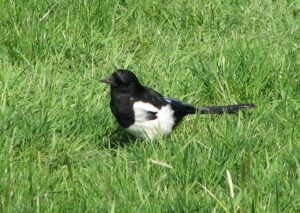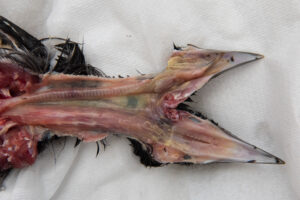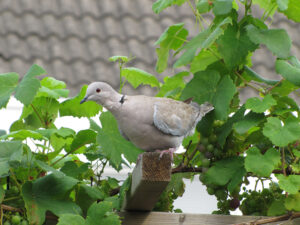Magpie with ‘pigeon canker’
In May 2018 a sick immature Eurasian Magpie (Pica pica) was brought to birdhospital Naarden where it died. The fresh cadaver was submitted to the DWHC for post-mortem investigation. The manager suspected that the magpie had died due to the disease ‘pigeon canker’. Post-mortem investigation confirmed that the magpie had died of inflammations in the mouth and oesophagus which were caused by the parasite Trichomonas gallinae.
‘Pigeon canker’
The disease that is caused by the parasite Trichomonas gallinae is ‘Pigeon canker’, and also known as trichomonosis and trichomoniasis. This disease is mainly seen in doves, greenfinches, and birds of prey that eat sick birds, and it is not dangerous for people, dogs or cats.
The parasite causes inflammations in the mouth, throat, crop, and oesophagus. This makes the bird unable to take in feed and water, causing the bird to starve and sometimes choke. The course of the illness can progress quite rapidly. There is often a yellow-white, pasty substance in the mouth, although other diseases might have a similar appearance, such as avian pox. Only investigation can confirm the cause of disease.
Bird species
As mentioned above, ‘pigeon canker’ is mainly seen in doves, greenfinches, and birds of prey that eat sick birds. Despite the known fact of its appearance in birds of prey and scavengers, trichomonosis is usually described as a disease of pigeons and greenfinches. In previous years, DWHC found the Trichomonas-parasite as the cause of disease in the following predatory birds: immature magpies, immature sparrow hawks, and in an adult hawk. In songbirds, the greenfinch is most susceptible, the common chaffinch is less susceptible and the disease is sporadically seen in hawfinches, Eurasian siskins, and in house sparrows. DWHC found the disease in multiple pigeon species, being Eurasian collared doves , common wood pigeons , stock doves, and feral pigeons. The -increasingly rare- European turtle dove has not been submitted to DWHC for post-mortem investigation yet, although it is known that ‘Pigeon canker’ causes death in this species.
´Pigeon canker´ and greenfinches
Even though trichomonosis seems to be the main cause of death in greenfinches in the Netherlands (and in other countries, like Great Britain) , it is not possible to say that every dead greenfinch has died of this disease. Other diseases have been found as cause of death in greenfinches, such as avian malaria , avian pox, and the Salmonella-bacteria.
Increase?
Often people ask if there are more reports than in the year before. The issue is that the amount of reports gets influenced by the amount of media attention that is given to this kind of diseases, and the knowledge of being able to report dead animals. Even though we now see a mild increase in the amount of reported dead greenfinches, it is not possible to conclude that there is a real increase in greenfinch deaths.
Reporting dead birds
Did you find a dead bird? Report them through the website of DWHC or Sovon ( Dutch). This is the only way to get a good insight in the mortality of birds through the years.







